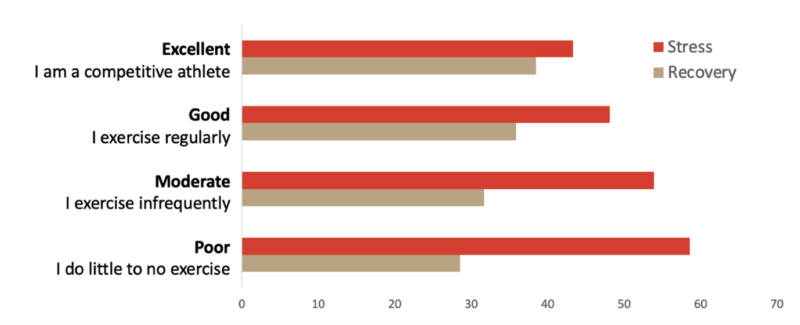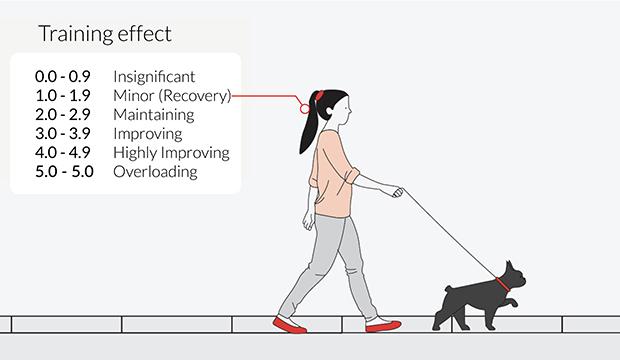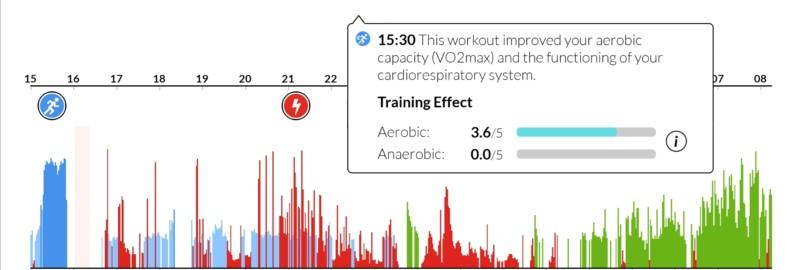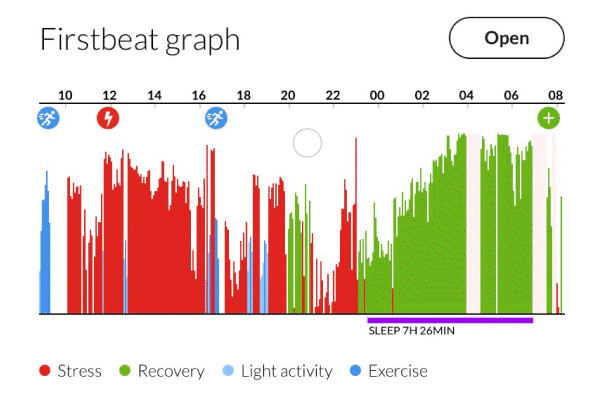
Physical activity and fitness level are associated with better recovery and stress management. Even a small increase in fitness improves your energy level and ability to recover. The Training Effect feature of Firstbeat Life wellness solution will help you optimize and balance your training better.
Diverse physical activity is important for both health and fitness development. At its best, alternating vigorous, moderate and light activity generates the biggest impact.
Light exercise alone is not enough to develop fitness, but maintains your ability to function and refreshes your body and mind. Constant strenuous exercise, on the other hand, can lead to exhaustion and limited recovery, which prevents further development of your fitness level.
To get the optimal benefits from exercise, it is important to adjust exercise intensity to suit your current fitness level and recovery state.

Physical fitness is associated with the amount of stress and recovery per day. Extensive Firstbeat data shows that individuals who exercise little have significantly more stress and less recovery than individuals who are physically active. Sufficient physical activity supports good recovery and stress management.
How Can You Monitor the Effect of Exercise on Your Fitness and Recovery?
In addition to stress, recovery and sleep, our Firstbeat Life also measures the effects of exercise on health and fitness development. The Training Effect (TE) feature available in the mobile app allows you to monitor the impact of your physical activity, adjust the intensity of your exercise and ensure that you recover adequately based on the total stress load of everyday life.
In practise, Training Effect scores the impact of exercise on your aerobic and anaerobic fitness using a scale of 0 to 5. You also receive brief verbal feedback on the effects of your exercise performance.
- Aerobic means the impact exercise has on your cardiorespiratory fitness and endurance.
- Anaerobic means the impact exercise has on your ability to perform at high-intensity by developing characteristics like power, speed and strength.


On a scale of 0 to 5, Training Effect shows the impact of an exercise session on your fitness. The Training Effect result is found in the Firstbeat Life graph.
When Should You Maintain and When Should You Improve?
Physical activity does not always need to include maximum effort, nor should it. A workout focussed on maintaining or improving aerobic fitness combined with a low anaerobic impact is actually excellent for your overall wellness.
For most of us who are not in competitive sports, we should not aim for the highest possible Training Effect. The main emphasis should be in maintaining our physical condition (TE 2.0 – 2.9) and occasional fitness-improving sessions (TE 3.0 – 3.9). Even the most active people, with excellent fitness, need lighter workouts on a regular basis to allow sufficient recovery and to further improve their fitness.
In addition to Training Effect, you should monitor sleep quality and your body resources. If you don’t sleep well and enough, your resources may not be restored, leaving you with low recovery and energy levels. With a good balance between exercise and rest, you have the best foundation for developing your fitness.
How Do You Develop Fitness and Improve Maximum Performance?
To improve your maximal performance requires regular workouts that result in a high aerobic or anaerobic training effect. However, high-intensity exercise should be carefully timed and followed by sufficient recovery to get a full benefit from the effort. Even top athletes need time to recover.
Demanding endurance workouts (aerobic TE 4.0 or higher) can quickly improve your fitness by increasing your maximal oxygen uptake (VO2max). Running, Nordic skiing, cycling, orienteering, and rowing are good examples of exercise, where you can keep your aerobic effort high for extended periods of time.
If you want to exercise hard, remember at least these three things:
- Highly improving training sessions (TE 4 or higher) require that you are used to regular exercise.
- Always warm up well before starting the high-intensity effort.
- Give your body enough time to recover afterwards, to get full benefit from the heavy effort.
When Should You Go Easy with Exercise?
If your sleep recovery is poor and your resources are constantly decreasing, your total load might be too high. Firstbeat Life provides feedback based on your result, to let you know if your resources are down.
If your overall load is high and resources low, try training easier for a while. Keep the TE of your workouts low until your recovery improves. When your resources start bouncing back, you can start including more strenuous workouts.
How to Find Firstbeat Life Training Effect?
You can find Training Effect and other information about your exercise when you open the detailed view of your Firstbeat Life graph (if the day included an exercise session).
- Open “Results” in your Firstbeat Life app and select the desired measurement.
- Go to the Exercise section and scroll down to the daily result. Click “Open” by the Firstbeat Life graph.
- If an exercise session was detected that day, you will see a blue and white exercise icon above the blue exercise bars. By clicking on the icon, you can see the aerobic and anaerobic training effect.
- Click on the i -info icon to get more details about the exercise, fox example average heart rate and energy expenditure.
You might also be interested in

Notifications on Poor Recovery: Take a Proactive Approach to Your Health
Physiological data can reveal how your body is coping with everyday life. But how do you know when you need to address certain issues? Personalized notifications in the Firstbeat Life solution let you know when your measurement results need extra attention.

Firstbeat Life and Wearables – What’s the Difference?
From HRV and sleep monitoring to recovery data, here’s how Firstbeat Life differs from wearables.

Firstbeat Life: How Do You Get Employees Engaged in Corporate Wellness?
When it comes to corporate wellness, one of the most common problems is getting employees engaged. So, what to do? Our specialist gives concrete tips, how to get employees commit to small changes.


